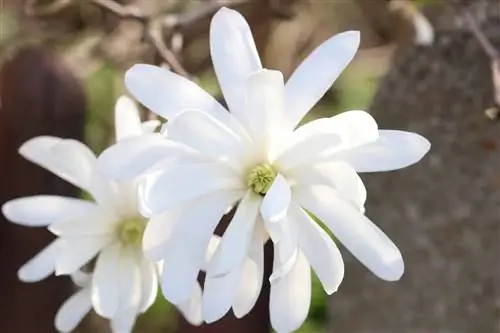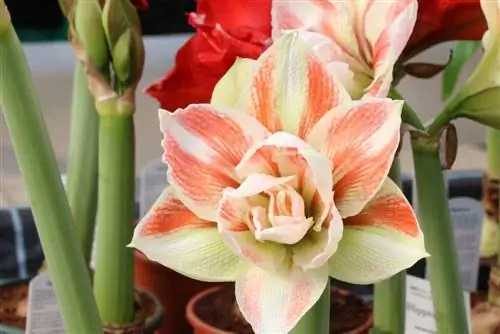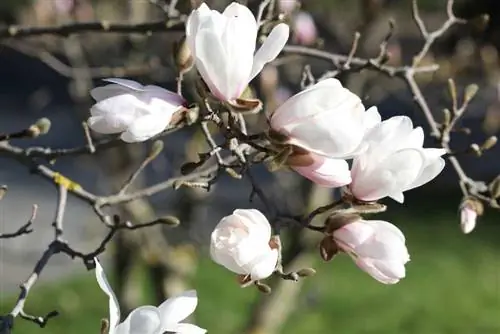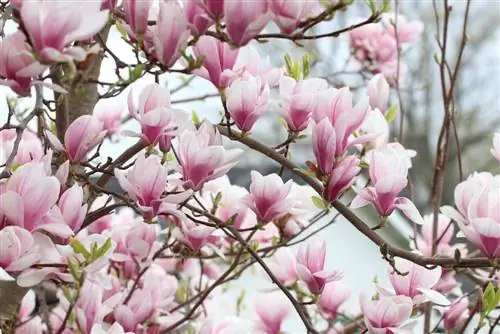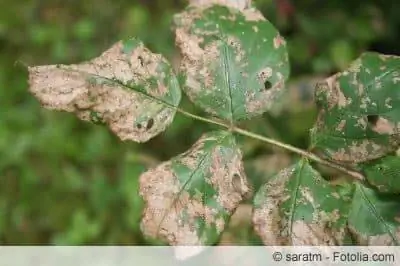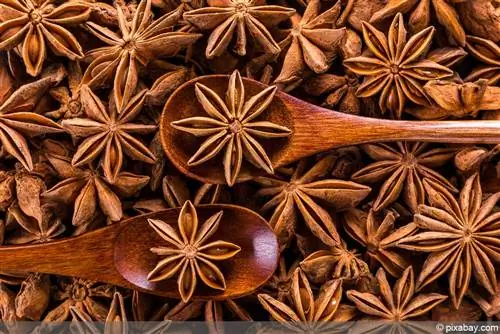- Author admin [email protected].
- Public 2023-12-17 03:39.
- Last modified 2025-01-24 12:45.
The star magnolia (Magnolia Stellata) has found its way from Japan to our western regions of the West. With its white flowers and tall growth, it looks very elegant and the easy care makes it a hit in the garden, on the terrace or in a large pot in the living room. If you don't care for the magnolias much, you can enjoy them forever and can multiply them effectively and plant them in other locations. A little help here is to provide all newcomers with the key data on rearing and care.
Sowing and location
If you want to sow the red seeds, you should do so immediately after the fruit has ripened. The best point for sowing is a box that is in the cold but protected from the worst of the frost. The seeds need a cold stimulus before they react. Germination sometimes only occurs in the second year. The germs should not be frozen in a block of ice. The plants will also need to be protected later in a low pot.
The best location is a moderately sunny spot in the garden. In principle, the plant does well in full sun, but due to the early flowering, too much sun can cause it to come on too early and the late frost destroys the inflorescences. As far as the soil is concerned, the plant is not demanding. Whether slightly acidic, basic, alkaline or slightly calcareous. If you spread some manure or compost around the plant every now and then, you will ensure there is sufficient supply of nutrients. Alternatively, small amounts of organic-mineral fertilizer (for example for rhododendrons or azaleas) can also be used.
Planting and repotting
Repotting the plant is generally only necessary once. If the plant has germinated in the pot and has already grown a few centimeters above the ground, it can be planted out in spring. If you want to keep the plant indoors and have planned a certain maximum size, you have to cut it like a bonsai. A deep pot is not necessary for this as the plant has quite shallow roots.
Suitable neighbors
As neighbors of the magnolia, deep-rooted plants are recommended. Stronger shallow roots, such as a chestnut, can rob the magnolia of its energy. In this case, a root barrier must be placed under the tree disc. Fertilizing should then also be done more regularly. Particularly suitable neighbors are magnolias in other colors to complement the view and make it even more impressive.
Watering and fertilizer
The plant is also very undemanding when it comes to watering. Watering should only be done if it has not rained and the soil around the plant appears to be dry. Waterlogging and too much moisture must be absolutely avoided! The star magnolia prefers it to be a little drier rather than too humid. If you overwater the plant, you will quickly experience deficiency symptoms. Leaves turning yellowish-whitish are an indication of this.
You should fertilize in spring when the star magnolia enters the vegetation phase. As described above, simple manure or compost can be used as fertilizer, which is simply raked lightly into the surface. You should be careful not to damage the roots. You can also use organic-mineral fertilizer. It is particularly recommended for rhododendrons or azaleas. Mulching around the plant saves fertilizing and requires even less watering. Every now and then the undergrowth, i.e. lawn etc., should be removed and compost or potting soil should be sprinkled. This step can also be saved with bark mulch.
Cutting and overwintering
If you want to cut the plant back, you should do so indirectly after flowering. In principle, this is not necessary; the plant should only be thinned out if necessary. Annual pruning is not necessary and should even be avoided. Overwintering the star magnolia is simply done outdoors. The plant does not need to be plucked out and brought inside. However, if you want the plant in a small pot, you should protect it from excessive frost and freezing moisture in the pot.
Propagation
Propagation takes place either via the red seeds of the fruits that the plant developed in autumn, or via cuttings, which is highly recommended due to the high growth rate of the plant and the long germination times of up to 2 years. Cutting the cuttings is done after flowering. The branches cut off with rose scissors are first placed in water for a few days and then in soil. As a tip for faster rooting: You can easily avoid root boosters from the store. Tip: Willow water works wonders when it comes to propagating cuttings. Simply take a few green, woody branches from a willow tree, cut them into approx. 2 cm pieces and soak them in water for 24 hours. This water is then ideal for growing roots from cuttings. After the first roots can be seen, it is recommended to leave the plant in a large pot for another month and then plant it outdoors.
The propagation via seeds takes place as already described: place in a cool pot full of soil and wait. Even despite a cold stimulus, it can take two winters until the germs start to sprout.
Diseases and pests
If the star magnolia is in a location that is too stressful, the leaves remain small and whitish. To remedy this, you should check whether there are other shallow-rooted plants nearby and, if necessary, install root stops. The soil must be checked for excessive density, waterlogging and the PH value. The star magnolia is very sensitive to soil compaction and if the pH value is too high, it must be balanced with a little sulfur powder. However, this practice rarely occurs in our soils. Mulching and fertilizing are enough to keep the plant he althy.
Pests are few: the so-called whitefly and the scale insect can easily be controlled with conventional pesticides. If leaf spots appear due to the Pesodomonas bacterium, the plant should be watered less. Infested stands are removed and cut back.
Tip:
In case of pest infestation, a nettle tincture that is compatible with the environment and he alth can help. Nettles are collected for this purpose. Let it soak in water for 1-2 days and then spray the liquid on the plant - it helps a lot against all kinds of lice.
Tips for speed readers
- If you love tulip magnolias but do not have enough space for their stately growth, you will find a suitable alternative in the star magnolia.
- The star magnolia is easy to care for. If you fertilize it every now and then and don't water it too regularly, you can enjoy it for a long time.
- The plant can be treated with a little care.
- Growing it as a bonsai is complicated: it should be expected that the first attempts to keep the plant small and in a pot will fail.
What you should know about the star magnolia in brief
Plants
- A front garden is ideal as a backdrop for a star magnolia. In any case, it deserves a place where it can be seen as an eye-catcher.
- If you want to plant a star magnolia, it is best to do so in autumn or spring.
- Star magnolias prefer acidic soil, similar to rhododendrons or azaleas.
If the soil condition does not correspond to this preference, planting is the best opportunity to adjust the soil accordingly: To do this, the planting hole should be larger than necessary so that a bag of rhododendron soil can fit in.
- Horn shavings have proven to be effective as a long-term fertilizer.
- After planting, the soil around the star magnolia must be pressed firmly and the plant watered well.
Care
- If it was planted in autumn, the young star magnolia definitely needs protection for the first winter so that it does not freeze.
- In very early flowering varieties, late night frosts can damage the flowers, even if the plants are older.
- It is therefore advisable to make sure when purchasing that the star magnolia is one of the later flowering species.
- Star magnolias are grateful for fertilizer in spring. A typical rhododendron or azalea fertilizer is suitable for fertilizing.
- If a layer of rhododendron soil is spread around the trunk instead of compost, the star magnolia will also benefit from it.
- Because the roots are very shallow in the soil, vigorous hoeing could damage the roots. That's why it's better to avoid it.
- It is also recommended to apply bark mulch in this area. This suppresses weeds and prevents the soil from drying out so easily.
- To care for the star magnolia, sufficient moisture must always be ensured. Especially in summer when it doesn't rain for a long time.
- Star magnolias don't actually need to be cut, unless they are too out of shape.

